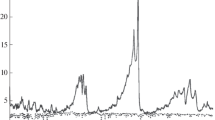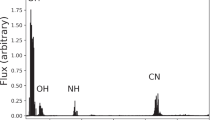Abstract
We report on simultaneous optical and infrared observations of the Halley Family comet 8P/Tuttle performed with the ESO Very Large Telescope. Such multi-wavelength and coordinated observations are a good example of what can be done to support space missions. From high resolution optical spectroscopy of the CN (0,0) 388 nm and NH2 (0,9,0) 610 nm bands using UVES at UT2 we determined 12C/13C = 90 ± 10 and 14N/15N = 150 ± 20 in CN and we derived a nuclear spin temperature of NH3 of 29 ± 1 K. These values are similar to those found in Oort-Cloud and Jupiter Family comets. From low resolution long slit spectroscopy with FORS1 at UT2 we determined the CN, C3 and C2 production rates and the parent and daughter scale lengths up to 5.2 105 km tailward. From high resolution IR spectroscopy with CRIRES at UT1 we measured simultaneously the production rates and mixing ratios of H2O, HCN, C2H2, CH4, C2H6, and CH3OH.
Similar content being viewed by others
Avoid common mistakes on your manuscript.
1 Introduction
Determining the composition of cometary nuclei is essential for understanding the formation and evolution of volatile material within our solar system. Observational evidence supports chemical diversity among comets that may reflect the diversity of conditions in comet-forming regions in the solar nebula.
However, comets experienced different processing histories whose importance has to be properly investigated both theoretically and observationally. The orbits of Halley-family comet (HFCs) have evolved to periods less than 200 years, making them the most processed Oort-cloud comets. However, HFCs are underrepresented in compositional surveys.
The 2008 apparition of comet 8P/Tuttle was an excellent opportunity to perform a detailed investigation of the composition of a HFC with modern techniques.
Observations during the 1980 apparition showed 8P/Tuttle to be typical in C2 abundance relative to H2O (C2/H2O ~4.1 × 10−3), with an inferred H2O production rate between ~1.6 and 5.7 × 1028 mol s−1 at a heliocentric distance (Rh) between 1.02 and 1.16 AU (A’Hearn et al. 1995).
2 Observing Circumstances
8P/Tuttle made a close approach to Earth at 0.25 AU on Jan 2, 2008. On Jan 16, 28 and Feb 4 UT, we undertook simultaneous spectroscopic observations in the near-infrared and the visible range using the CRIRES, FORS1 and UVES instruments installed at the UT1 and UT2 units of the Very Large Telescope (VLT) of the European Southern Observatory (ESO). The observing circumstances are given in Table 1. The weather was cloudy on the visitor mode night of Jan 16 and only UVES spectra could be used. On the two other nights (service mode) simultaneous observations with the three instruments were performed, the weather was clear and the seeing was 0.5–1.5″.
3 C and N Isotope Ratios, NH2 OPR
The high resolution spectroscopic observations in the optical domain (λ/Δλ = 80000, [303–1004 nm]) had several objectives, among which measurements of carbon and nitrogen isotopic ratios and the ortho-to-para (OPR) ratio in NH2.
Synthetic spectra of 12C14N, 13C14N, 12C15N (0,0) bands at 388 nm were computed using a fluorescence model (Zucconi and Festou 1985). The isotope mixture was adjusted to best fit the observed continuum subtracted spectrum (Arpigny et al. 2003). This is illustrated in Fig. 1. The carbon isotopic ratio found in 8P/Tuttle (12C/13C = 90 ± 20) is in agreement with other comets and with the terrestrial and solar value (89). The 15N enrichment (14N/15N = 150 ± 25) with respect to the terrestrial atmospheric value (272) is consistent with the value observed in about 20 comets of the Oort-Cloud and Jupiter-Family types (Manfroid et al. 2009, in preparation).
A small part of the CN (0,0) mean spectrum (black line). The positions of the 13C14N (red ticks) and 12C15N (blue ticks) isotopic lines are indicated. The synthetic spectrum with 12C/13C = 90 and 14N/15 N = 150 is superimposed (blue line). The red dotted line is the synthetic spectrum without 13C14N and 12C15N (Color figure online)
The red part of the UVES spectra gives access to the NH2 (0,9,0) band at 610 nm, which was used to measure the OPR of NH2 on the basis of a fluorescence excitation model (Kawakita et al. 2001) (Fig. 2). A mean OPR of 3.29 ± 0.07 was derived, providing a nuclear spin temperature of NH3 of Tspin = 29 ± 2 K in agreement with measurements in other comets (27–35 K). If Tspin is correlated with the location of formation of the comet in the solar nebula, the Halley type comet 8P/Tuttle formed in a similar environment as most of the Oort-Cloud and Jupiter-family comets.
4 CN, C3 and C2 Density Profiles, Production Rates and Scale Lengths
Long slit spectroscopy (λ/Δλ = 440, [330–660 nm]) was performed to measure the radial distributions of the CN, C2, C3 radicals and their parent production rates, in order to constrain their origin. The slit was put along the tail and offsets were applied in order to cover continuously the coma up to 5.2 105 km in the tail direction. Spatial profiles of the gaseous emissions of CN [3830–3905 Å], C3 [3975–4150 Å] and C2 [4860–5210 Å] were extracted by integrating the flux densities over the above cited wavelength ranges (Fig. 3). The fluxes were then converted to column densities.
The Haser model was used to fit the CN, C3 and C2 column density profiles and to derive production rates, parent (lp) and daughter (ld) scale lengths (Table 2). For CN, the spatial coverage was not sufficient on the sunward side, so that the scale lengths were fixed to the values measured tailward. A parent and daughter expansion velocity of 1.0 km/s was assumed.
C2/CN and C3/CN production rate ratios are consistent with values measured by narrowband photometry (Schleicher IAUC8903, pers.com.) and fall near the mean values for typical comets according to A’Hearn et al. (1995) taxonomy (as already observed at previous 8P apparitions).
For CN the sunward side is not well fitted with the (lp, ld) parameters measured tailward. The CN parent scale length is not fully in agreement with that one expected from the photodissociation of HCN. Using the Haser-equivalent model, the photodissociation rates of 1.55 × 10−5 s−1 (HCN), 3.2 × 10−6 s−1 (CN) (Bockelée-Morvan and Crovisier 1985, Huebner et al. 1992) and a CN ejection velocity of 0.86 km/s (Fray et al. 2005) one gets lp = 4.5 104 km and ld = 4.0 105 km to be compared with the measured values of 3.5 × 104 km and 1.9 × 105 km, respectively. The comparison of the CN and HCN production rates presented in the next section suggests that HCN is not the major source of CN in this comet. A possible candidate is C2N2 (Bockelée-Morvan and Crovisier 1985; Festou et al. 1998; Fray et al. 2005). However, using the C2N2 photodissociation rate and CN ejection velocity of 2–3 km s−1 given by Bockelée-Morvan and Crovisier (1985), we infer an equivalent parent scale length lp = 0.6–1.2 × 104 km much shorter than observed.
The fits for C2 are the poorest. A complex chemistry model is needed to reproduce the C2 and C3 profiles as these species are produced in more than one reaction step from several parent species (Helbert et al. 2005).
5 Mixing Ratios and Production Rates of Parent Molecules
Infrared high resolution spectroscopy observations (λ/Δλ = 50000, [2.9–3.3 μm]) with CRIRES were conducted to measure the production rates and abundance of several parent molecules (Fig. 4). An important objective was to compare HCN and C2H2 production rates to those of their daughter products CN and C2 observed simultaneously with FORS 1 (Table 3).
The mixing HCN/H2O ratio is lower, by a factor of 3, than the mean value of 0.26% (Disanti and Mumma 2008) measured in Oort-Cloud comets from IR observations. A similar conclusion is reached from millimetre observations (Biver et al. 2008) and from the NIR observations of Bonev et al. (2008) and Boehnhardt et al. (2008). Strong depletions of C2H2 and C2H6 are also observed, compared to the mean value in Oort-Cloud comets but the CH3OH and CH4 mixing ratios are typical.
The CN/HCN ratio is ~3, suggesting that there is another source of CN in the coma. This has been already noticed for a number of comets (Fray et al. 2005).
A similar conclusion is reached for C2, as the C2/C2H2 ratio is ~8.
References
M. A’Hearn et al., Icarus 118, 223 (1995). doi:10.1006/icar.1995.1190
C. Arpigny et al., Science 301, 1522 (2003). doi:10.1126/science.1086711
N. Biver et al., in Asteroids, Comets, Meteors, LPI Contribution No. 1405, Baltimore, MD, 14–18 July 2008
D. Bockelée-Morvan, J. Crovisier, Astron. Astrophys. 151, 90 (1985)
H. Boehnhardt et al., Astrophys. J. 683, L71 (2008)
B.P. Bonev et al., Astrophys. J. 680, L61 (2008)
M.A. DiSanti, M.J. Mumma, Space Sci. Rev. 138, 127 (2008)
M. Festou et al., BAAS 30, 1089 (1998)
N. Fray et al., P&SS 53, 1243 (2005)
J. Helbert et al., Astron. Astrophys. 442, 1107 (2005)
W.F. Huebner et al., Ap&SS 195, 1 (1992)
H. Kawakita et al., Science 294, 1089 (2001)
J.-M. Zucconi, M. Festou, Astron. Astrophys. 150, 180 (1985)
Author information
Authors and Affiliations
Corresponding author
Additional information
Based on observations collected at the European Southern Observatory, Paranal, Chile (ESO Prog. 080.C-0615 and 280.C-5053).
Rights and permissions
About this article
Cite this article
Jehin, E., Bockelée-Morvan, D., Dello Russo, N. et al. A Multi-Wavelength Simultaneous Study of the Composition of the Halley Family Comet 8P/Tuttle. Earth Moon Planet 105, 343–349 (2009). https://doi.org/10.1007/s11038-009-9317-8
Received:
Accepted:
Published:
Issue Date:
DOI: https://doi.org/10.1007/s11038-009-9317-8








